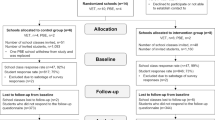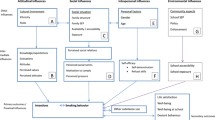Abstract
This study investigated both substantive and methodological issues associated with school-based smoking prevention programs. Substantive issues included the efficacy of a refusal skills training curriculum and of parent messages mailed to students' homes. Methodological issues included the effects of assigning classrooms versus entire schools to experimental conditions and determination of the effects of attrition on internal and external validity. Results revealed differential impact for different subgroups of adolescents. The refusal skills program produced lower rates of smoking than the control condition for students who were smokers at the pretreatment assessment but may have produced detrimental effects among males who were nonsmokers at pretest. The provision of parent messages did not affect outcome. Method of assignment (schools versus classrooms) failed to produce significant effects, and attrition did not affect internal validity. However, the above differential findings, as well as the impact of attrition on external validity, raise questions concerning the generalizability of smoking prevention programs.
Similar content being viewed by others
References
Ary, D. V., Biglan, A., Nautel, C. L., Weissman, W., and Severson, H. H. (1983). Longitudinal prediction of the onset and change in rate of adolescent smoking. Paper presented at the Fifth World Conference on Smoking and Health, Winnipeg, Canada.
Bauman, K. E., and Dent, C. W. (1982). Influence of an objective measure on self-reports of behavior.J. Appl. Psychol. 67(5): 623–628.
Bell, D., Associates (Producer) (1977).The Feminine Mistake (film), Pyramid Films, Los Angeles. (Supported by a grant from the American Cancer Society.)
Best, J. A., Flay, B. R., Towson, S. M. J., Ryan, K. B., Perry, C. L., Brown, K. S., Kersell, M. W., and d'Avernas, J. R. (1984). Smoking prevention and the concept of risk.J. Appl. Soc. Psychol. 14(3): 257–273.
Biglan, A., and Ary, D. V. (1985). Current methodological issues in research on smoking prevention. In Bell C., and Battjes, R. (eds),Prevention Research: Deterring Drug Abuse Among Children and Adolescents, NIDA Research Monograph, Washington, D.C.
Biglan, A., McConnell, S., Severson, H. H., Bavry, J., and Ary, D. V. (1984). A situational analysis of adolescent smoking.J. Behav. Med. 7(1): 109–114.
Biglan, A., Gallison, C., Ary, D. V., and Thompson, R. (1985). Expired air carbon monoxide and saliva thiocyanate: Relationships to self-reports of marijuana and cigarette smoking.Addict. Behav. 10: 137–144.
Biglan, A., Severson, H. H., Ary, D. V., Faller, C., Gallison, C., Thompson, R., Glasgow, R., Lichtenstein, E. (1987). Do smoking prevention programs really work? Attrition and the internal and external validity of an evaluation of a refusal skills program.J. Behav. Med. 10: 159–171.
Botvin, G. J., and Wills, T. A. (1986). Personal and social skills training: Cognitive-behavioral approaches to substance abuse prevention. In Bell, C., and Battjes, R. (eds.),Prevention Research: Deterring Drug Abuse Among Children and Adolescents, NIDA Research Monograph, Washington, D.C.
Botvin, G. J., Baker, E., Renick, N., Filazzola, A. D., and Botvin, E. M. (1984). A cognitive-behavioral approach to substance abuse prevention.Addict. Behav. 9: 137–147.
Chassin, L., Corty, E., Presson, C. C., Olshavsky, R. W., Bensenberg, M., and Sherman, S. J. (1981). Predicting adolescents' intentions to smoke cigarettes.J. Health Soc. Behav. 22: 445–455.
Cook, T. D., and Campbell, D. T. (1979).Quasi-experimentation: Design and Analysis Issues for Field Settings, Rand McNally, Chicago.
Evans, R. I. (Director) (1976).Resisting Pressures to Smoke (film), Social Psychological Deterrents of Smoking in Schools Project, Houston, Tex.
Evans, R. I., Hansen, W. B., and Mittelmark, M. (1977). Increasing the validity of self-reports of behavior in a smoking in children investigation.J. Appl. Psychol. 62(4): 521–523.
Evans, R. I., Rozelle, R. M., Maxwell, S. E., Raines, B. E., Dill, C. A., Guthrie, T. J., Henderson, A. H., and Hill, P. C. (1981). Social modeling films to deter smoking in adolescents: Results of a three-year field investigation.J. Appl. Psychol. 66: 399–414.
Flay, B. R. (1985). Psychosocial approaches to smoking prevention: A review of findings.Health Psychol. 4: 449–488.
Flay, B. R., Johnson, C. A., Hansen, W. B., Grossman, L. M., Sobel, J. L., and Collins, L. M. (1983). Evaluation of a school-based, family-oriented, television-enhanced smoking prevention and cessation program: The importance of implementation evaluation. Paper presented at the joint meeting of Evaluation Network and the Evaluation Research Society, Chicago, Oct.
Flay, B. R., Ryan, K. B., Best, J. A., Brown, K. S., Kersell, M. W., d'Avernas, J. R., and Zanna, M. P. (1985). Are social psychological smoking prevention programs effective? The Waterloo Study.J. Behav. Med. 8(1): 37–59.
Friedman, L. S., Lichtenstein, E., and Biglan, A. (1985). Smoking onset among teens: An empirical analysis of initial situations.Addict. Behav. 10: 1–13.
Hansen, W. B., Collins, L. M., Malotte, C. K., Johnson, C. A., and Fielding, J. E. (1985). Attrition in prevention research.J. Behav. Med. 8: 261–276.
Hirschman, R. S., Leventhal, H., and Glynn, R. (1984). The development of smoking behavior: conceptualization and supportive cross-sectional data.J. Appl. Soc. Psychol. 14: 184–206.
Jessor, R., and Jessor, S. L. (1977).Problem Behavior and Psychosocial Development: A Longitudinal Study of Youth, Academic, New York.
Johnson, C. A., Hansen, W. B., Collins, L. M., and Graham, J. W. (1984).Final Report: The High School Anti-Smoking project (report to NIDA), Health Behavior Research Institute, University of Southern California, Los Angeles.
Lichtenstein, E., Glasgow, R. E., and Abrams, D. A. (1987). Social support in smoking cessation: In search of effective interventions.Behav. Ther. (in press).
McAlister, A. L., Perry, C., Killen, J., Slinkard, L. A., and Maccoby, N. (1980). Pilot study of smoking, alcohol, and drug abuse prevention.Am. J. Public Health 70: 719–721.
McCaul, K. D., and Glasgow, R. E. (1985). Preventing adolescent smoking: What have we learned about treatment construct validity?Health Psychol. 4: 361–387.
Murray, D. M., Johnson, C. A., Luepker, R. V., and Mittelmark, M. B. (1984). The prevention of cigarette smoking in children: A comparison of four strategies.J. Appl. Soc. Psychol. 14(3): 274–288.
Murray, D. M., O'Connell, C. M., Schmid, L. A., and Perry, C. L. (1987). The validity of smoking self-reports by adolescents: A reexamination of the bogus pipeline procedure.Addict. Behav. (in press).
O'Neill, H. K., Glasgow, R. E., and McCaul, K. D. (1983). Component analysis in smoking prevention research: Effects of social consequences information.Addict. Behav. 8: 419–423.
Pechacek, T., Murray, D. M., Luepker, R. V., Mittlemark, M. B., Johnson, C. A., and Shultz, J. M. (1984). Measurement of adolescent smoking behavior: Rationale and methods.J. Behav. Med. 7(1): 123–140.
Schinke, S. P., and Gilchrist, L. D. (1983). Primary prevention of tobacco smoking.J. School Health 53(7): 416–419.
Severson, H. H., and Ary, D. V. (1983). Sampling bias due to consent procedures with adolescents.Addict. Behav. 8: 433–437.
U.S. Public Health Service (1982).The Health Consequences of Smoking: Cancer. A Report of the Surgeon General, Department of Health and Human Services, Washington, D.C.
Author information
Authors and Affiliations
Additional information
This research was supported in part by Grant HD 13409 from the National Institute of Child Health and Human Development, by Grant DA 03635 from the National Institute of Drug Abuse, and by Grant CA 38273 from the National Cancer Institute. The authors would like to thank the teachers, students, and school administrators who made this study possible and the many staff members at ORI who worked on the project.
Rights and permissions
About this article
Cite this article
Biglan, A., Glasgow, R., Ary, D. et al. How generalizable are the effects of smoking prevention programs? Refusal skills training and parent messages in a teacher-administered program. J Behav Med 10, 613–628 (1987). https://doi.org/10.1007/BF00846658
Accepted:
Issue Date:
DOI: https://doi.org/10.1007/BF00846658




